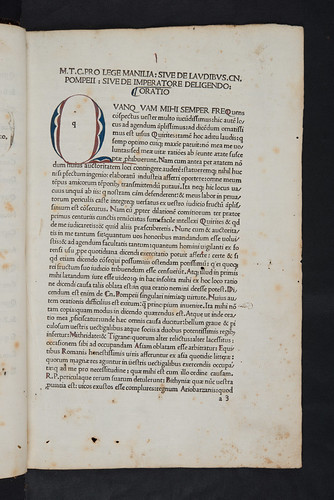Cicero, Marcus Tullius: Orationes.
Edited by Ludovicus Carbo.
Venice: Nicolaus Girardengus, de Novis, 10 Mar. 1480.
Fol. a12 b-e10 f-p8 q-r6 ſ8 s-u8 xx-zz8 &&8 aa10 x-z10 &10 A-B10 C8. [286] leaves.
ISTC ic00545000; Goff C545; BMC V 272; Bod-inc C-244; GW 6767.
| Shelf-mark: | Sp Coll Hunterian By.2.7 (see main library entry for this item) |
| Bound with: | In this copy the blank leaf after o4 has not been excised. |
| Provenance: | Conrad Schwäger (fl. 1567), Doctor of Theology, Tirschenreuth, Bavaria: inscription on a1r “Sacræ Theologiæ D. Conradus Schwägerius 1567”. Straubingen, Bavaria, Carmelites: inscription on a2r “Carmeli Straubingani”. Edward Harley (1689-1741), Lord Harley; from 1724 2nd Earl of Oxford: evidence from binding. Thomas Osborne (d. 1767), bookseller: purchased all the Harleian printed books; no. 5055 in his 'Catalogus bibliothecae Harleianae', vol. 1 (London: 1743); Osborne’s price “1 1 0” in pencil on front flyleaf. William Hunter (1718-1783), physician and anatomist: source unknown. University of Glasgow: Hunterian bequest 1807; Hunterian Museum bookplate on front pastedown, with former shelfmark “As.2.3”. |
| Binding: | England, 18th-century gold-tooled red morocco; bound for Lord Harley by Christopher Chapman. On both covers triple fillets form two concentric frames: within the outer frame is a floral roll (Nixon, ‘Harleian bindings’, pl. 13), and within the inner frame is an ornamental roll (Nixon, ‘Harleian bindings’, pl. 14, Chapman roll 1); both covers have a lozenge-shaped centre-piece, made up of several individual tools (including Nixon, ‘Harleian bindings’, pl. 15, Chapman nos 1a, 1b, 5, 14a, 14b, and 16). The head and foot of the spine are decorated with Chapman roll 2 (Nixon, ‘Harleian bindings’, pl. 14), and the tools used in the spine compartments include Nixon, ‘Harleian bindings’, pl. 15, Chapman no. 4; the turn-ins are decorated with Chapman roll 2; marbled endpapers; flyleaves have fleur-de-lys watermark and countermark “I V”. Size: 316 x 223 mm. |
| Leaf size: | 303 x 203 mm. |
| Annotations: | Occasional marginal annotations, “nota” marks, underlining and pointing hands in a 15th/16th-century hand; erratic foliation in roman numerals in red ink in an early hand; signatures xx-zz lightly scored through in an early hand and altered to x-z, likewise signature && changed to [con], and signatures x-z, &, A-C changed to bb-hh. |
| Decoration: | Seven-line initial “Q” on a3r supplied in red and blue with reserved white; other initials throughout supplied in red with reserved white, or in red alone; paragraph marks and capital strokes in red. |
| Imperfections: | None. |





